Building with No-Fines Concrete
One of the biggest challenges faced by the Segmental Retaining Wall (SRW) industry is maximizing usable space while minimizing cost. All too often, an owner will opt for a cast in place (CIP) wall or a big block wall over using a traditional geogrid reinforced SRW. They reason that excavation for proper geogrid embedment will be either cost or space prohibitive. However, in a number of these situations, SRW’s can still be the most effective solution when used in conjunction with no fines concrete (NFC). No fines concrete, as the name implies, is simply a concrete product that doesn’t contain sand or fine materials. NFC is used to greatly increase gravity wall heights while maintaining a minimal excavation depth..
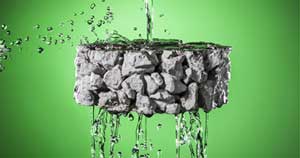
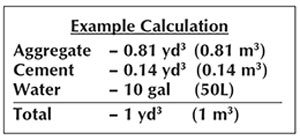
The idea of NFC is not a new concept. NFC dates back to the 1800s in Europe. It was originally created for the sake of cost savings by minimizing cement and sand requirements. It gained popularity in the wake of WWII across Europe because cement supplies were limited. NFC was first used in segmental retaining walls over twenty-five years ago.
The concept of NFC is simple. Begin with a coarse aggregate material with an average size of 0.75 in (20 mm) with no material less than 0.325 in (10 mm). Mix aggregate with cement in a six to one ratio. Once the cement is thoroughly mixed with the aggregate, add water in the volume indicated to the right, do not over water the mix. Rocks should appear thoroughly coated but not runny. Because NFC is mixed using coarse aggregate, it is quite porous and until cured will have a slump similar to wet aggregate by itself. NFC is sometimes referred to as pervious concrete, porous concrete or permeable concrete. However, in regards to retaining wall design, NFC is different from these other mixes in one very important way. The aggregate size for the others is much smaller and thus they are much less porous. NFC with the larger aggregates allow water to pass easily through it just like the washed Wall Rock in a traditional geogrid reinforced wall.
NFC should be considered a modified structural fill for walls. The inclusion of cement enhances the soil friction angle of the aggregate that can be best described as a permanent type of cohesion once the mix is cured. Independent testing was conducted to determine conservative values for both the internal friction angle and the shear strength of NFC. The final test report provided an average friction angle of 77.2 degrees and an average shear strength of 1400 psi (9.62 MPa). Common shear strength values will range from 900 to 1400 psi (6.18 to 9.62 MPa). From a structural design standpoint, NFC structures can be easily evaluated using a modified Bishops analysis through a method called Internal Compound Stability (ICS). For an in depth discussion on ICS please see the ICS Tech Sheet.
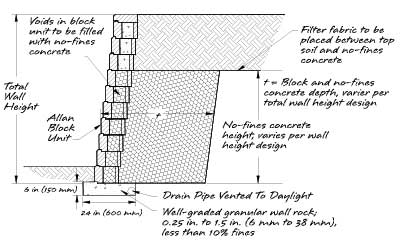
There are a number of situations that warrant the consideration of NFC. The most common scenario is when space is of the utmost concern. Whether the wall is placed tightly with a property line or an owner is looking to maximize their usable space, NFC allows contractors to build taller with less excavation. Industry standards recommend a minimum of sixty percent of total wall height be used for geogrid embedment depth. However, forty percent of the total wall height is a common depth for NFC. Less excavation translates to more usable space and a reduced cost of installation.
Another situation where NFC can present significant cost savings is a site with walls specified as big block gravity walls. By using NFC, contractors can add a significant amount of weight and depth to the facing making their wall mimic the overall size and stability of a big block gravity wall at a greatly reduced cost. Furthermore, by using NFC with Allan Block retaining wall units, contractors can effectively eliminate the need for heavy equipment on site. This means retaining walls can be installed with smaller crews, smaller equipment, and further reduced costs. There is also a large shipping cost savings to be had. Due to the extraordinary weight of just one big block, every truck can transport a much greater square footage of Allan Block per load.
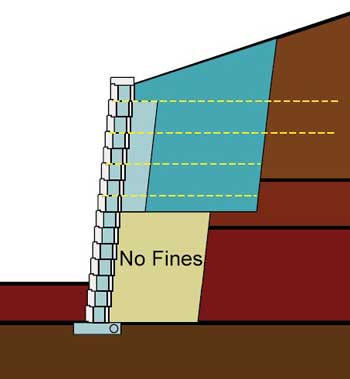
A third common application of NFC is in Complex Composite Structures (CCS). CCS is a term used generally to describe retaining wall structures that incorporate multiple reinforcement methods or soil types. For example, consider a site having a sizable retaining wall in close proximity to bedrock for a portion of its height. The retaining wall can be designed and constructed using NFC at the bottom until it reaches the height of the bedrock. Once the wall has cleared the bedrock height, geogrid reinforcement may be used for the remainder of construction. Conversely, if a wall is being built in close proximity to future building foundations a contractor might begin with geogrid and transition to NFC at the top of the wall. No fines concrete can be a simple solution to a variety of challenges that a site might present.
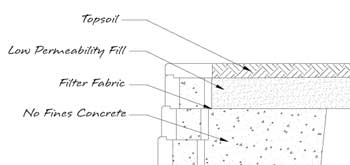
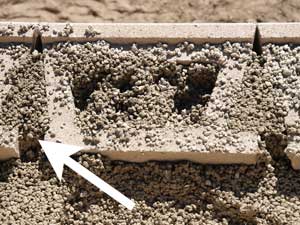
Remove one back wing per block.
Building retaining walls using NFC is similar to building them with structural fill. In fact, in some ways it is easier to install a retaining wall using NFC. Begin by creating a leveling pad of compacted gravel base and setting the base course of block as detailed in the AB Commercial Installation Manual. Next, fill all the voids in the base course and backfill to the specified depth with NFC. There is no need to compact NFC. Simply move it around with a shovel and it will begin to cure in a short time. When constructing straight sections of wall using NFC, Allan Block recommends removing one back wing per block (as shown here). This will allow NFC to flow into the void between the block webs which helps to secure the block face to the NFC backfill. The vertical lift of a pour should not exceed 16 in. (400 mm) or two courses of block. This will allow for the installer to easily rod the NFC into the cores of the lower course ensuring the voids are full. It is not required to let the NFC cure between pours because it will start to cure soon after being placed. For this reason, it is sometimes referred to as stabilized aggregate. You can continue to pour the NFC mix until the two course lift is roughly level with the top block without concern of having high hydraulic loads build up behind the block. Before allowing the NFC to cure, excess material must be brushed off the top of the block to aid in the installation of the following courses of block. If any NFC spills onto the face of the block, it is important to remove it before it cures. Using a brush and clean water helps to remove the cement past. Repeat this process until the wall has reached its designed height. The top may be finished just like a typical segmental retaining wall with filter fabric topped with 8 to 12 in. (200 to 300 mm) of low permeability fill or topsoil.
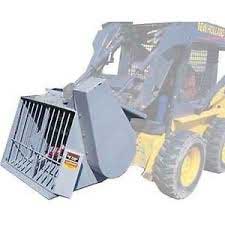
There are a number of ways to mix NFC and to pour it behind the wall. Depending on the size and complexity and access to the site you may employ the use of a ready-mix truck directly from a local plant, use a portable on-site concrete mixer, or a ribbon mixer attachment on a skid steer. However your NFC is mixed the next step is getting it to the wall. The most common way to transport the NFC mix is in the bucket of your skid steer. This will allow you to transport a large quantity to even the most difficult wall locations on site. Ultimately each site will dictate the most effective mixing and transportation option that will be the most cost effective for your project.
There are many advantages to using NFC. Contractors can build walls quickly and with less excavation in difficult sites to solve a variety of negative site conditions. The use of NFC backfill also eliminates the need for compaction and compaction testing of the reinforced soil and it provides superior wall drainage since the entire “wall” mass is permeable. NFC eliminates the need for wall rock in the cores and behind the wall facing. The use of NFC to overcome the various site obstacles can greatly reduce costs on many projects compared to other options.
For information regarding retaining wall design using no fines concrete see our Tech Sheet on No Fines with AB Walls Design Software.
See the No-Fines Concrete Estimating Chart for more information.


